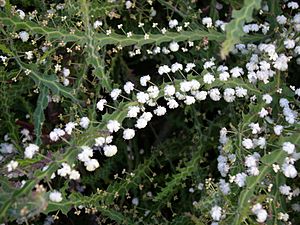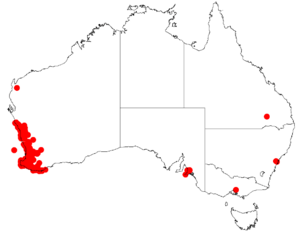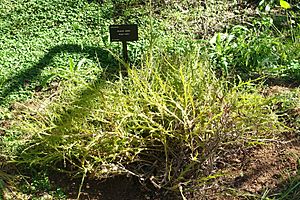Acacia alata facts for kids
Quick facts for kids Acacia alata |
|
|---|---|
 |
|
| Scientific classification | |
| Genus: |
Acacia
|
| Species: |
alata
|
 |
|
| Occurrence data from AVH | |
Acacia alata is a cool shrub often called the winged wattle. It belongs to a big group of plants called Acacia. This plant is special because of its unique "winged" stems that look like leaves.
Contents
What is the Winged Wattle?
The winged wattle is a tough, bushy plant. It has many branches and can grow from about 30 centimeters (1 foot) to 2.1 meters (7 feet) tall. It can also spread out about 1 meter (3 feet) wide. Its small branches often bend in different directions, giving it a unique look.
How Does it Look?
The winged wattle has special parts that look like leaves. These are called phyllodes. They are actually flattened stems that act like leaves. These phyllodes are usually 2 to 20 millimeters (0.08 to 0.8 inches) wide. They can be 5 to 70 millimeters (0.2 to 2.8 inches) long. Each phyllode ends in a sharp spine. This plant can handle cold weather, even frosts down to about -7 degrees Celsius (19 degrees Fahrenheit).
When Does it Bloom?
Acacia alata flowers between April and December. Its flowers grow in small, round clusters. Each cluster usually has 4 to 15 tiny flowers. These flowers can be white, cream-colored, or a bright golden yellow. The golden yellow flowers are often chosen by people who grow these plants in gardens.
How is the Winged Wattle Classified?
Scientists group living things into categories. This helps us understand how they are related. The Acacia alata was first officially described by a botanist named Robert Brown. He wrote about it in 1813 in a book called Hortus Kewensis.
There are four main types, or varieties, of Acacia alata:
- Acacia alata var. alata
- Acacia alata var. biglandulosa
- Acacia alata var. platyptera
- Acacia alata var. tetrantha
Where Does the Winged Wattle Grow?
This plant is found all along the west coast of Western Australia. You can see it from north of Geraldton down to areas around Albany. It grows well in many different kinds of soil. You might find it near streams, on rocky hills, or in flat areas with clay or even salt pans.
See also
 In Spanish: Acacia alata para niños
In Spanish: Acacia alata para niños



